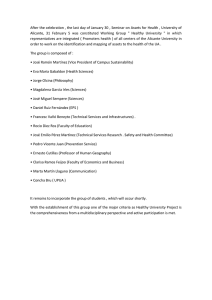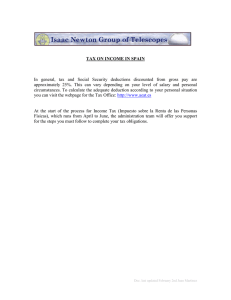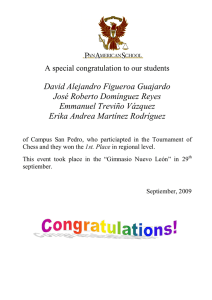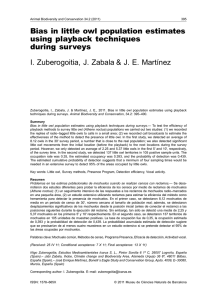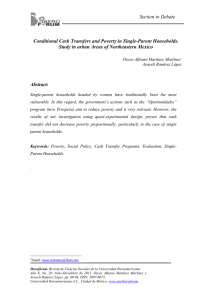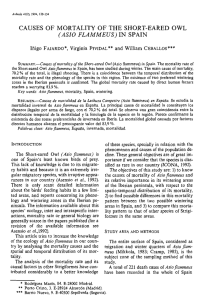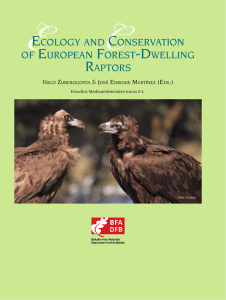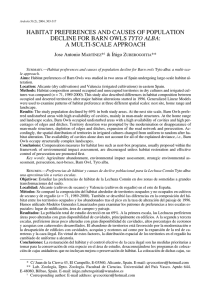Full article
Anuncio
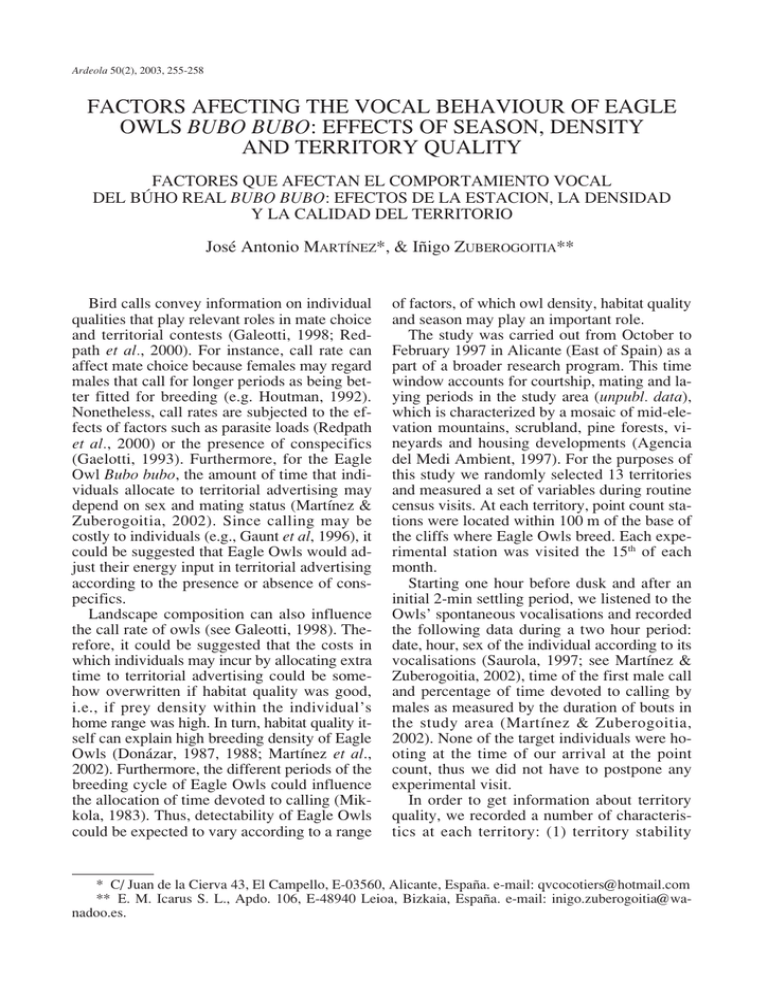
Ardeola 50(2), 2003, 255-258 FACTORS AFECTING THE VOCAL BEHAVIOUR OF EAGLE OWLS BUBO BUBO: EFFECTS OF SEASON, DENSITY AND TERRITORY QUALITY FACTORES QUE AFECTAN EL COMPORTAMIENTO VOCAL DEL BÚHO REAL BUBO BUBO: EFECTOS DE LA ESTACION, LA DENSIDAD Y LA CALIDAD DEL TERRITORIO José Antonio MARTÍNEZ*, & Iñigo ZUBEROGOITIA** Bird calls convey information on individual qualities that play relevant roles in mate choice and territorial contests (Galeotti, 1998; Redpath et al., 2000). For instance, call rate can affect mate choice because females may regard males that call for longer periods as being better fitted for breeding (e.g. Houtman, 1992). Nonetheless, call rates are subjected to the effects of factors such as parasite loads (Redpath et al., 2000) or the presence of conspecifics (Gaelotti, 1993). Furthermore, for the Eagle Owl Bubo bubo, the amount of time that individuals allocate to territorial advertising may depend on sex and mating status (Martínez & Zuberogoitia, 2002). Since calling may be costly to individuals (e.g., Gaunt et al, 1996), it could be suggested that Eagle Owls would adjust their energy input in territorial advertising according to the presence or absence of conspecifics. Landscape composition can also influence the call rate of owls (see Galeotti, 1998). Therefore, it could be suggested that the costs in which individuals may incur by allocating extra time to territorial advertising could be somehow overwritten if habitat quality was good, i.e., if prey density within the individual’s home range was high. In turn, habitat quality itself can explain high breeding density of Eagle Owls (Donázar, 1987, 1988; Martínez et al., 2002). Furthermore, the different periods of the breeding cycle of Eagle Owls could influence the allocation of time devoted to calling (Mikkola, 1983). Thus, detectability of Eagle Owls could be expected to vary according to a range of factors, of which owl density, habitat quality and season may play an important role. The study was carried out from October to February 1997 in Alicante (East of Spain) as a part of a broader research program. This time window accounts for courtship, mating and laying periods in the study area (unpubl. data), which is characterized by a mosaic of mid-elevation mountains, scrubland, pine forests, vineyards and housing developments (Agencia del Medi Ambient, 1997). For the purposes of this study we randomly selected 13 territories and measured a set of variables during routine census visits. At each territory, point count stations were located within 100 m of the base of the cliffs where Eagle Owls breed. Each experimental station was visited the 15th of each month. Starting one hour before dusk and after an initial 2-min settling period, we listened to the Owls’ spontaneous vocalisations and recorded the following data during a two hour period: date, hour, sex of the individual according to its vocalisations (Saurola, 1997; see Martínez & Zuberogoitia, 2002), time of the first male call and percentage of time devoted to calling by males as measured by the duration of bouts in the study area (Martínez & Zuberogoitia, 2002). None of the target individuals were hooting at the time of our arrival at the point count, thus we did not have to postpone any experimental visit. In order to get information about territory quality, we recorded a number of characteristics at each territory: (1) territory stability * C/ Juan de la Cierva 43, El Campello, E-03560, Alicante, España. e-mail: qvcocotiers@hotmail.com ** E. M. Icarus S. L., Apdo. 106, E-48940 Leioa, Bizkaia, España. e-mail: inigo.zuberogoitia@wanadoo.es. 256 MARTÍNEZ, J. A. & ZUBEROGOITIA, I. (OCUPP), as measured by the number of years of territory persistence irrespective of ownership during the period 1992-2000 (see Korpimäki, 1988; Galeotti, 1998), (2) percentage of scrubland (SCRUB) in a circle of 25 km2 around the nests and (3) topographic irregularity (REL) in a circle of 25 km2 around the nests. The 25 km2 circle around the nests was chosen because it may simulate the Eagle Owl’s home range and because the models of habitat preference developed at this scale explained the highest percentages of deviance among a set of different scales (Martínez et al., 2002). This model pointed out that the surface of scrubland (measured on maps and aerial photographs at 1:5000 scale) within the simulated home ranges was the best predictor of the presence of Eagle Owls, probably because the surface of scrubland is a good estimator of the presence of Rabbits Oryctolagus cuniculus (Moreno & Villafuerte 1995), which are the Owl’s main prey in the study area (Martínez & Zuberogoitia, 2001). The variable ‘topographic irregularity’ was chosen because of its high power for predicting the nesting habitat of the Eagle Owl in the study area (Martínez et al., 2002). It was measured as the number of 100-m contours cut by four 2.8 km lines starting from the nests in directions N, S, E and W. The nearest neighbour distance (NND) was used as an inverse measure of Eagle Owl density (Solonen, 1993). Females, unlike males, were seldom heard during the experimental visits but in the visits in November and December (Martínez & Zuberogoitia, 2002). Therefore, all analyses are referred to males. All males were paired, as confirmed by spring surveys. Among the wide vocal repertoire of the Eagle Owl, we recorded mainly territorial and alarm calls. The booming territorial call of the male is clearly distinguishable from the sonorous, high-pitched alarm call, which is best known as ‘the devil’s laughter’ (Mikkola, 1983; Saurola, 1997). We found significant differences in the onset of calling between individual Owls during the five months of the study period (repeated-measures ANOVA; F1,2 = 9.51; P = 0.031; Fig. 1). We also found differences in the amount of time that Owls devoted to calling from October to February (repeated-measurements ANOVA; F1,12 = 86.16; P < 0.001). Owls emitted mainly FIG. 1.—Seasonal variation in the onset of calling of male Eagle Owls in relation to Owl density. Each point represents the monthly average for the 13 birds and its standard deviation). [Variación en la media de la hora de comienzo de emisión de llamadas espontáneas de machos de Búho Real en relación con la densidad de individuos. Cada punto representa la media mensual para 13 individuos y su desviación estándar.] Ardeola 50(2), 2003, 255-258 EFFECTS OF SEASON, DENSITY AND TERRITORY QUALITY territorial calls (77% of the calls). During the course of this study, alarm calls (23% of the calls) were only heard in areas where the nearest neighbour distance was less than 1,200 m. Although alarm calls are delivered during the whole length of the breeding period in the study area, they are heard mostly between November and February (unpubl. data). In order to test for possible relationships between the amount of time that the Owls spent calling (dependent variable) and territory quality, we performed multiple regression analysis (Stepwise Forward method; Hosmer & Lemenshow, 1989) using SCRUB, REL, OCUPP and NND as independent variables. The only variable included in the model was SCRUB (Table 1). TABLE 1 Logistic regression model for the relationship between the amount of time that Eagle Owls spend calling and their territory quality. [Modelo de regresión logística para la relación entre la cantidad de tiempo que los Búhos Reales pasan cantando y la calidad del territorio.] Variable [Variable] Scrubland [Matorral] Constant [Constante] B SE [ES] Wald P 0.03 0.002 5.72 < 0.001 –1.236 0.501 When presented with simulated male territorial intrusions, females responded by increasing the mating-begging call rate, paired males responded aggressively and unpaired males ceased hooting (Martínez & Zuberogoitia, 2002). This suggests that paired males defend mate and territory, whereas unpaired males hoot mainly in order to attract mates. Consequently, it could be suggested that in high-density areas paired males allocate more time to territorial advertising in order to keep floaters or neighbours from pursuing extra-pair copulations with their mates. This would explain why, during the course of our study, alarm calls were recorded mostly in high-density areas and during the courtship-mating period. Starting to call early in high-density areas would allow Eagle Owls to proclaim territory ownership, maintain the pair bound and then hunt soon after dusk, 257 when a peak on the activity of rabbits occur (Arques, 2000). Our finding that the percentage of scrubland within the simulated home ranges was the best predictor of the amount of time that Owls spent calling may support this suggestion, as it could be put forward that Eagle Owls breeding in prey-rich areas (as estimated by the surface of scrubland) also engaged in prolonged vocal displays in order to advertise their resource holding potential to females, i.e, their ability to obtain and defend resources (Parker, 1974). In terms of the energy expenditure of the individual, the high availability of energetically profitable preys in their home ranges may overwrite the possible costs brought about by prolonged vocal contests. Although we have no direct estimates of prey availability, the abundance of rabbits in the study area is surely high, as shown by the fact that gamekeepers release small game for hunting (Bermejo, 2000). Nevertheless, the possible effects of Owl density on individual fitness ought to be tested more directly. In conclusion, the amount of time that Eagle Owls allocated in territorial advertising varied monthly (Fig. 1) and was influenced by the amount of good hunting grounds within their home ranges. During the period when territory ownership is first reassured and females may assess male quality (early October to mid December), owls started calling considerably earlier than during the period when territory ownership has been ascertained and mating is more likely (mid December to late February; Mikkola, 1983; Cramp & Simmons, 1985). Therefore, census work, specially when carried out during the early stages of the breeding cycle (November and December) would benefit from starting one hour before dusk and finishing at least one hour after dusk. The use of this time frame should guarantee a sufficient probability of detection of Eagle Owls throughout the breeding season. Our results further stress the importance of small game and scrubland management, as the availability of prey-rich areas may affect the daily energetic expenditure of Eagle Owls as estimated by the amount of time that they allocate in territorial advertising. This is amenable to the finding that low abundance of rabbits has detrimental effects on the number of breeding pairs and on the breeding success of the Eagle Owl (Martínez & Zuberogoitia, 2001; Ardeola 50(2), 2003, 255-258 258 MARTÍNEZ, J. A. & ZUBEROGOITIA, I. Martínez & Calvo, 2001; Penteriani et al., 2002). Structural features of the calls such as tonal quality or rhythm must also bee taken into account in order to validate our suggestions, as they may also be related to male resource holding potential (Galeotti, 1998). RESUMEN.—El estudio se realizó entre octubre y febrero de 1997 en 13 territorios de Búho Real en Alicante (España). Para obtener información sobre la calidad de los territorios se midió la (1) estabilidad del territorio (OCUPP) desde 1992 a 2000, (2) el porcentaje de matorral en 25 km2 alrededor del nido (SCRUB), (3) la irregularidad topográfica (REL) en el mismo área y (4) la distancia al territorio vecino más cercano (NND). La única variable que se relacionaba con el tiempo dedicado al canto por parte de los machos de Búho Real, era el porcentaje de matorral en el territorio. Esto parece indicar que el tiempo dedicado a cantar por estos machos podría ser un indicativo de la calidad del territorio que poseen, al estar relacionado la variable SCRUB con la cantidad de conejo, principal presa de esta especie. AKNOWLEDGEMENTS.—Fernando Falcó, HELIACA, A. Izquierdo, J. Izquierdo, Luis Rico, Fran, Paco Segarra, Pep Cantó, M. J. Payá, Tony Zaragozí and Luis Fidel helped in the location of the territories. David Serrano and Mario Díaz made valuable comments on the manuscript. BIBLIOGRAPHY Agencia del Medi Ambient, 1997. Mapa geocientífico de la Provincia de Alicante. Generalitat Valenciana. Valéncia. ARQUES, J. 2000. Ecología y gestión cinegética de una población de conejos en el Sur de la provincia de Alicante. Tesis Doctoral. Universidad de Alicante. Alicante. BERMEJO, S., 2000. Memoria de Caza del Coto de Agua Amarga 1990-2000. Sociedad de Caza de Agua Amarga. Alicante. CRAMP, S. & SIMMONS, K. (Eds.) 1985. The Birds of the Western Paleartic. Vol II. Oxford University Press. Oxford. DONÁZAR, J. A. 1987. Espaciamiento y dispersión de nidos de Búho Real Bubo bubo en Navarra (Norte de la Península Ibérica). Munibe, 40: 35-58. DONÁZAR, J. A. 1988. Selección de hábitat de nidificación por el Búho Real (Bubo bubo) en Navarra. Ardeola, 35: 233-246. GALEOTTI, P. 1993. Differential responses of territorial Tawny Owls Strix aluco to the hooting of neighbours and strangers. Ibis, 135: 300-304. Ardeola 50(2), 2003, 255-258 GALEOTTI, P. 1998. Correlates of hoot rate and structure in male Tawny owls Strix aluco: implications for male rivalry and female mate choice. Journal of Avian Biology, 29: 25-32. GAUNT, A., BUCHER, T., GAUNT, S, & BAPTISTA, L. 1996. Is singing costly? Auk, 113: 718-721. HOSMER, D. W. & LEMENSHOW, S. 1989. Applied logistic regression. Wiley & Sons. New York. HOUTMAN, A. 1992. Female zebra finches choose extrapair copulations with genetically attractive males. Proceedings of the Royal Society of London, 249: 3-6. KORPIMÄKI, E. 1988. Effects of territory quality on occupancy, breeding performance and breeding dispersal in Tengmalm’s owl. Journal of Animal Ecology, 57: 97-108. MARTÍNEZ, J. A. & ZUBEROGOITIA, I. 2001. The response of the Eagle Owl (Bubo bubo) to an outbreak of the rabbit haemorrhagic disease. Journal für Ornithologie, 142: 204-211. MARTÍNEZ, J. A. & ZUBEROGOITIA, I. 2002. Factors affecting vocal behaviour of Eagle Owls Bubo bubo: effects of sex and mating status. Ardeola, 49: 1-9. MARTÍNEZ, J. A., SERRANO, D. & ZUBEROGOITIA, I. 2002. Predictive models of habitat preferences for the eagle owl bubo bubo: a multiscale approach. Ecography 26: 21-28. MARTÍNEZ, J. E. & CALVO, J. F. 2001. Diet and breeding success of the Eagle Owl in southwestern Spain: effect of rabbit haemorrhagic disease. Journal of Raptor Research, 35: 259-262. MIKKOLA, H. 1983. The Owls of Europe. T. & A. D. Poyser. Carlton. MORENO, S. & VILLAFUERTE, R. 1995. Traditional management of scrubland for the conservation of rabbits and their predators in Doñana National park, Spain. Biological Conservation, 73: 81-85. PARKER, G. 1974. Assessment strategy and the evolution of fighting behaviour. Journal of Theoretical Biology, 47: 223-243. PENTERIANI, V., GALLARDO, M. & ROCHE, P. 2002. Landscape structure and food supply affect the eagle owl (Bubo bubo) breeding performance: a case of population heterogenety. Journal of Zoology, London, 357: 365-372. REDPATH, S., APPLEBY, B. & PETTY, S. 2000. Do male hoots betray parasite loads in Tawny Owls? Journal of Avian Biology, 31: 457-462. SAUROLA, P. (Ed.) 1997. Suomen Pöllöt. Kirjayhtymä Oy. Helsinki. SOLONEN, T. 1993. Spacing of birds of prey in southern Finland. Ornis Fennica, 70: 129-143. UEDA, K. 1993. Effects of neighbours. Costs of polyterritoriality in the fan-tailed Warbler. Cisticola juncidis. Ethology, Ecology and Evolution, 5: 177-180. [Recibido: 15-05-02] [Aceptado: 11-07-03]
